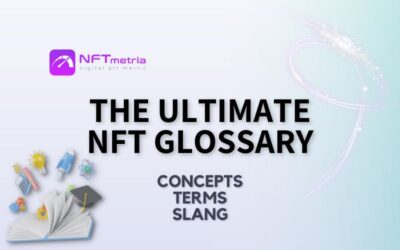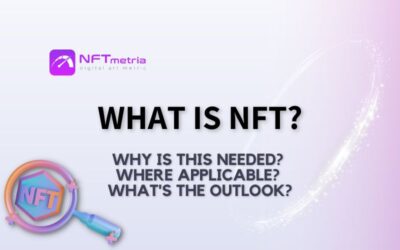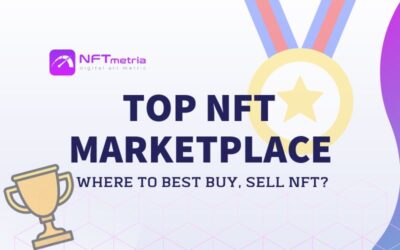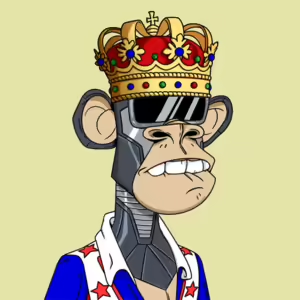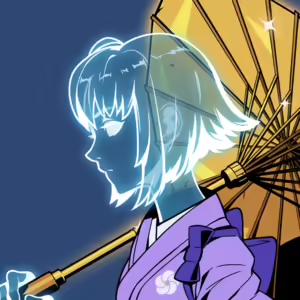In the realm of NFTs, enthusiasts employ an extensive array of terms and jargon. Some of these terms originate from traditional stock exchanges, while others have emerged in the past few years. To stay abreast of current developments, comprehend discussions, and communicate effectively, our team has curated the definitive NFT Glossary. We’ve compiled all the essential terms you should be familiar with. Additionally, take note of the links provided, which will lead you to in-depth articles on specific topics.
Airdrop
The process of freely distributing cryptocurrency, NFTs, tokens, etc., typically involves specific conditions, such as inviting people to the project or completing simple tasks like liking and reposting content on the project’s social media platforms.
All-Time High and All-Time Low
All-Time High (ATH) and All-Time Low (ATL) refer to the highest and lowest price levels that a coin or token has ever reached, respectively.
Allocation
Distribution of limited assets, in this case NFTs, refers to the allocation of a specific number of assets to participants. For instance, if the total allocation is 1,000 NFTs, this is the quantity that will be distributed among all participants.
Alcoins
These cryptocurrencies, commonly referred to as altcoins, emerged after the introduction of Bitcoin to the market. Their purpose was to address the technical limitations of Bitcoin and explore the broader potential of blockchain technology.
Blockchain
Blockchain is a decentralized, encrypted information storage technology owned by no single entity. Essentially, it functions as a registry with data stored in blocks, including transaction lists. When one block is full, a new block is created and linked to the previous one, forming a chain of blocks, commonly known as a blockchain. Records within the blockchain are tamper-proof due to its decentralized nature, meaning the data is simultaneously stored on multiple devices. Any record that doesn’t match the consensus is considered invalid. All records are secured through advanced cryptography. Blockchain serves as the fundamental technology for NFTs.
The most popular blockchains in the NFT market include:
Blue-chip NFT collections
Blue-chip NFT collections refer to projects that have consistently shown high and stable market value, along with a strong long-term potential. These projects are backed by reputable and influential teams in the industry, and boast a dedicated and extensive community. Blue-chip collections represent the cream of the crop in the NFT market, including well-known names such as Bored Ape Yacht Club, Azuki, CryptoPunks, CLONE X.
Burning
Burning in the context of NFTs refers to the deliberate destruction or removal of an NFT from circulation. Essentially, a token is ‘burned’ to decrease the supply, thereby increasing the value of the remaining tokens. This process involves sending the token to an unowned address. While the NFT still technically exists on the blockchain, it becomes inaccessible and is effectively considered ‘burned,’ indicating its removal from circulation.
CC0 license
The CC0 license, or Creative Commons Zero License, is the most permissive form of license that permits individuals to upload, utilize, modify, exhibit, or otherwise create any work under its terms. This license offers unrestricted opportunities for use, making it highly advantageous for NFT projects. Several notable NFT projects, including CyberKongz, Moonbirds, Nouns, and others, utilize the CC0 license, allowing for maximum flexibility and accessibility in their creative endeavors.
DAO
A Decentralized Autonomous Organization (DAO) is an entity governed by computer code and specific programs, functioning independently without human intervention or dependence on human creators. The operational framework of a DAO, from monitoring products in a vending machine to fully automating large-scale organizations, is defined by its creators. While fully automated DAOs with zero human involvement are rare due to the complexity of the technology, many NFT projects implement a modified version: each token owner possesses a proportional vote, enabling participation in the project’s decisions. Examples of such DAOs include ApeCoin DAO and Loot (for Adventurers).
DAPP
A DAPP, or Decentralized Application, operates without a backend on a decentralized computer system, such as a blockchain. Instead of relying on the hardware and software components of the application, all necessary computations are performed across multiple computers on a blockchain. This approach enhances speed, transparency, and reliability.
DeFi
DeFi, short for Decentralized Finance, encompasses a range of services and applications built using blockchain technology, cryptocurrencies, tokens, and smart contracts. These components are integrated into a unified network, providing users with services typically offered by banks and other financial institutions. Essentially, DeFi represents an alternative banking sector that can be accessed by individuals who prefer not to engage with or are unable to access traditional financial institutions. Over time, it has the potential to replace the outdated traditional banking sphere. In the NFT market, NFT lending has emerged as a popular DeFi service.
Dutch auction
Dutch auction is a type of auction commonly utilized during the minting of collections. The process begins with a high starting price, which gradually decreases until all digital assets are sold out or a predetermined time limit expires. Projects like Karafuru, PROOF Collective, and SuperNormal have adopted this approach for their minting processes.
DYOR
DYOR stands for Do Your Own Research. It means conducting thorough research on a project independently to ensure its legitimacy and credibility.
Farm
Farm refers to numerous devices with multiple accounts, either created or purchased, to enhance the likelihood of minting NFTs during giveaways and events.
Fiat
Fiat refers to national paper currencies, also known as symbolic or unsecured currencies. Unlike the Gold Standard era, these currencies are not backed by precious metals but derive their value from the state’s assurance and public trust. The value of fiat money is regulated by the state’s central bank, controlling issuance and the key lending rate to private banks, essentially representing our everyday paper money.
Flipping
Flipping refers to the practice of purchasing an asset and swiftly reselling it for a modest profit, often repeated multiple times.
Floor price
Floor price represents the minimum set price for items within a collection.
FOMO
FOMO, or Fear of Missing Out, refers to the strong urge to buy a particular currency or NFT due to its rapid price increase, often driven by emotions rather than rational decision-making.
Hash
Hash is a mathematical function that converts a set of symbols with arbitrary values into an encrypted code of a specific length. Each transaction has its unique hash, recorded in blocks on the blockchain, ensuring its distinctiveness and preventing replication.
Hold
“Hold” refers to the act of holding a token in a wallet for an extended period, typically a year or more, with the expectation of its global growth. The term “holder” is a slang word used to describe the owner of such digital assets.
Gas
“Gas” refers to the unit of measure for the fee associated with trading operations on the Ethereum network. This fee is given to miners as a reward for providing computing power to the network, and it is referred to as gas or fuel.
Gem
A “gem” refers to a potentially lucrative asset that is often undervalued and overlooked among others.
Gwei
“Gwei” is the denomination of Ethereum (ETH), similar to cents for the dollar, where 1 ETH is equivalent to 1 billion gwei. This term is commonly used in the context of GAS, for instance, the transaction fee can be 150 gwei.
ICO
ICO, or Initial Coin Offering, is the initial sale of tokens at a discounted price before they become publicly available. This enables the company to secure more investments at the early stage, and if the issuing team develops an attractive product using these tokens, there’s a chance that the token prices will significantly increase after going public, offering substantial benefits to early buyers.
IEO and IDO
IEO (Initial Exchange Offering) and IDO (Initial DEX Offering) are fundraising events organized on cryptocurrency exchanges. IEOs are controlled by centralized exchanges, whereas IDOs take place on decentralized exchanges, allowing projects to raise funds and distribute tokens directly to investors.
IPFS
IPFS (InterPlanetary File System) is a protocol for decentralized data storage and access. It distributes files across network nodes and establishes routes to the nearest node when accessing a file, ensuring high download speeds. Similar to BitTorrent, IPFS allows downloading file fragments from different nodes, making it efficient for large files. Many NFT marketplaces use IPFS for storing NFTs due to its free and decentralized nature.
KYC
“Know Your Customer” – User identification requirements for anti-money laundering, which are usually required by exchanges and ICOs. Such verification can vary, but usually passport information is needed.
Listing
Listing refers to the process of placing NFTs on a marketplace to initiate trading.
M2E
M2E, or Move-to-Earn, is a recent earning model, notably advocated by the STEPN project. Unlike Play-to-Earn (P2E), M2E rewards users not for in-game achievements but for their physical activities tracked through phone sensors. In essence, the more you walk or run, the more you can earn.
Make X’s
When the price of an asset rises several times (for example, they say that it makes x10) from the level at which it was bought, it brings the buyers a net profit of 100%, 200%, 1,000%, etc. of their investment.
Mining
Mining refers to the process of renting out computing power to calculate transactions, create new records, and verify their compatibility with existing ones within a blockchain. Miners play a crucial role in ensuring the network’s functionality, and they are rewarded in the form of the network’s native currency, often in the form of transaction fees.
Mint
Minting refers to the process of transforming a regular image, GIF, or track into a Non-Fungible Token (NFT). During minting, the item is recorded on the blockchain, establishing ownership and authenticity. Minting an NFT means being the first to claim rights to a specific digital asset on the web.
NFA
An abbreviation that stands for “not financial advice”; it means that the given information is solely the author’s opinion and personal investment decision, and is not a call to action.
NFT
NFT, or “Non-Fungible Token,” is a unique digital token that lacks equivalence. Unlike fungible tokens like USDT, each NFT is distinct and holds unparalleled value. These tokens represent ownership of digital assets and transactions recorded on the blockchain network, ensuring indisputable ownership proof.
Node
A node is a computer running specific software, integral to blockchain networks. It verifies information in new blocks, ensuring consistency with previous blocks and preventing duplicate currency transactions.
OTC
“Over-the-Counter” refers to a secondary market where individuals directly sell services or tokens without intermediaries like exchanges.
Pump and dump
“Pump” denotes a deliberate surge in liquidity, often planned, to maximize the price of an NFT. “Dump” is the intentional devaluation. These terms typically describe manipulation schemes involving obscure projects. Assets are bought in bulk, inflating their price (pump) and attracting other investors. Manipulators then sell, reaping profits and crashing the price (dump), causing losses for other investors. These terms broadly apply to any situation involving sudden price fluctuations, often influenced by those manipulating the market intentionally or inadvertently.
P2E
Play-to-Earn (P2E) games feature their own economies, enabling players to earn real money through activities like staking, farming in-game currency, or creating tokens within the game. All in-game items and resources exist as NFTs within the blockchain, ensuring their uniqueness and ownership.
Roadmap
A project’s roadmap outlines developers’ plans and tasks, indicating the project’s future development stages and their timelines. It serves as a crucial indicator of a project’s reliability, demonstrating what users can expect. However, effective marketing sometimes substitutes for a detailed roadmap.
Royalty
In the NFT realm, royalty refers to the bonus given to the author with each resale of their work, calculated as a certain percentage of the resale amount received by the seller.
Rug pull
A slang term describing a scenario where developers abandon a project or withdraw support while investors are left with financial losses. Unfortunately, rug pulls are notorious scams in the NFT space.
Scam
A scam refers to an investment project that, for various reasons, fails to pay out returns to investors or engages in fraudulent activities to deceive individuals for financial gain. In a broader context, it encompasses any fraudulent scheme designed to cheat people out of money.
Shilling
Shilling involves any online activity aimed at promoting projects for personal gain. This can range from individuals promoting projects in Discord channels and small Twitter accounts to influential figures like John McAfee and Elon Musk attempting to influence the entire market for their own benefit.
Smart contract
A smart contract is a program that verifies if the conditions of a digital asset exchange between a seller and a buyer are met. If the conditions are fulfilled, the transaction is completed; otherwise, the assets are returned to the owner. Within the blockchain, smart contracts perform various functions, including the ability to swap one NFT for another in a user’s collection. These functions often operate behind the scenes, unnoticed by the average user.
Tokens and smart contracts enable the digitization of real-world assets, allowing them to be traded in cryptocurrency.
Staking
Staking refers to a passive income method in cryptocurrency where individuals earn rewards by holding digital assets in their wallets. This process utilizes the Proof of Stake (PoS) algorithm, which rewards users based on their ownership share; the more assets in the wallet, the higher the reward. The main risk associated with staking is the potential decrease in the value of the held asset; if the coin’s price drops, the reward percentage (e.g., 10%, 20%, or 100%) will also decrease.
Swap
A swap involves the exchange of one cryptocurrency asset for another at a predetermined rate, either between two users or between a user and a cryptocurrency exchange.
Usability
Usability refers to the ease of use of an application or website. In the NFT world, it signifies the usefulness of a token for the buyer (also known as Utility). Usability assesses whether a specific NFT grants access to private chats, exclusive usage rights, discounts in other projects, or if it’s merely a digital image (commonly referred to as “zero Usability”).
Volatility
Volatility, in traditional financial markets, indicates the price spread of an asset over a specific period, reflecting how much a security fluctuates around its average price. Higher volatility generally implies higher investment risk. In the context of the NFT market, volatility holds the same meaning.
WETH
Wrapped ETH (WETH) is a tokenized version of Ethereum’s native cryptocurrency, Ether (ETH). Since most DeFi applications in the Ethereum network work with ERC-20 tokens and ETH doesn’t adhere to this standard (as it predates its acceptance), WETH was introduced. WETH simplifies the exchange process on the Ethereum network.
As Ethereum’s native currency was created before the ERC-20 standard, it cannot directly be exchanged for other ERC-20 cryptocurrencies. WETH acts as a wrapped version of ETH, making it compatible with ERC-20 tokens. This wrapping process has no impact on ETH’s value, maintaining a 1:1 ratio. WETH can be issued on various blockchains, including Polygon, Binance Smart Chain, Solana, Near, Avalanche, and Fantom.
Whales
The term “whales” refers to large holders of digital assets whose actions can significantly impact the asset’s price. Often, NFT influencers are among these whales, giving them the power to influence the market.
Whitelist
A whitelist is a limited list of individuals, often project partners or active supporters, who are guaranteed the opportunity to buy NFTs from a project. Typically, the number of people wanting to mint NFTs exceeds the available tokens. The conditions for getting on a whitelist vary, and even meeting these criteria doesn’t guarantee a spot; luck often plays a role. To participate, individuals usually need accounts on platforms like Twitter and Discord, where details about whitelists and airdrops are commonly shared, as these platforms are popular among NFT users.
Yield Farming
Yield farming is a method to earn cryptocurrency using assets you already own. In a broader sense, it refers to any effort to make crypto assets generate maximum profit. Yield farming involves strategies to optimize the returns on these assets.

